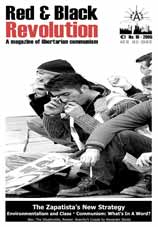Over 30 years of anarchist writing from Ireland listed under hundreds of topics
A look at the Situationists
The Situationists are mostly known to anarchists as a group that had something to do with the May 1968 Paris Uprising. However, the Situationists played a relatively peripheral role in the disturbances. Although much of the graffiti that appeared around the city (some famous ones included : "Never Work" and "All Power to the Imagination") were taken from Situationist works, the group did not play a major role in initiating the revolt themselves. The Situationist International formed in 1957 from two avant-garde groups, COBRA, (a group that sought to to renew art, architecture, and the action of art of life), and the Lettrist International, a tiny, postwar neo-dada anti-art movement. The Situationists were an avant-garde group that took artistic and cultural revolution just as seriously as political revolution. Although the Situationists could be described as an "anti-art" movement, this needs qualifiers to properly clarify their position. The Situationist family tree begins with Dada, the anti-art movement formed in Zurich at the legendary Cabaret Voltaire.
Dada
Dada as a movement was wholly negative, rejecting entirely all the values of bourgeois society. Though Debord saw that it was Dada’s wholly negative definition that precipitated its almost immediate breakup, he did not seem to apply the lessons of Dada’s decline to the case of the Situationist’s own decline.
Surrealism
Surrealism, the art-form which followed on from Dada, sought to give expression to the unconscious, which, through techniques like automatic writing, would give the artist access to a previously untapped and what Andre Breton and fellow artists of the time believed to be an inexhaustible source of inspiration.
Unfortunately as Debord saw in his "Report on the Construction of Situations"(1957), "The error that is at the root of surrealism is the idea of the infinite wealth of the unconscious imagination". As Debord and the Situationists saw it, surrealism's great failure was that it "wanted to realise art without suppressing it" - thus surrealism eventually became a gallery-bound art movement far removed from its original ideal of transforming everyday life through art.
The Lettrist International
The Lettrist International, and later, the Situationists themselves, wished to destroy Art as a separate, special activity but only so it could be re-constituted as an integral, and indeed the driving force of life itself.
Anarchism and the Situationists
One the major differences between Anarchism and the Situationist project was the exclusiveness of the project itself. There were only 10 members at most at any time, and many were expelled by Debord very quickly, over what seem to be the utmost trivialities. For example, Constant, the utopian architect from Amsterdam, was expelled because a guy who worked with him built a church, this apparently was too disastrous an influence for him to continue to be associated with the project!
The Situationists were a lot more concerned with developing a strong theory and critique than building a network of people willing to work with them. It was more important to Debord and those in his close inner circle (Raoul Vanageim and Michele Bernstein) that they possessed this unassailable unity of theory and action, than if they were "corrupted" by members who did not fully understand the nature of the project. It has to be said that this uncompromising stance seemed often to amount to not a lot more than agreeing with all of Debord's ideas. Practical, real-world actions were risky for SI members since there seemed to be such a high likelihood they might be seen as"reformist" or not revolutionary enough, which would result in expulsion.
It is possible to view the Situationist project as one that attempted to initiate a new revolutionary project which greatly emphasised the importance of cultural revolution. In practice however, the Situationists functioned mainly as a group that, although they claimed to have moved beyond Dada's nihilism, engaged themselves primarily in a total critique of existing society and culture.
The idea of "The Spectacle" is central to the Situationist critique i.e - "All that was once lived directly has become mere representation". In our 21st Century culture of Reality TV Shows, Soap Operas and Concerts like "Live 8" watched simultaneously by billions worldwide, it might well be argued that we have entered a new era of the Spectacle, where its domination is more far-reaching and omnipresent than ever before.
The Situationists believed that the primary effect (indeed, the goal) of this "immense accumulation of spectacles" was to create the maximum level of alienation in workers' everyday lives. The Spectacle's overwhelming (indeed inescapable) predominance would also require "the downgrading of being into having". To bring this up-to-date one need take only a quick look at MTV programming - "Cribs", "Pimp My Ride" or magazines like "Stuff".
The legacy of Situationism can also be seen in the "Culture Space Jamming" movement, popularised by Adbusters, who have unfortunately reformulated their approach and now seek to create a new "grassroots capitalism" - seen most clearly in their production of the "guaranteed produced by union-labor" "Black Spot" Sneaker. The Situationist project remains of great relevance today to the Anarchist movement, since they remind us that if we are to have a political revolution, it should necessarily also be a cultural revolution, in which we eliminate the division between actor/musician and spectactor, to enable a wholly non-alienated society to emerge.
by Lucien Ducasse
From Red and Black Revolution 10, Jan/Feb 2005


